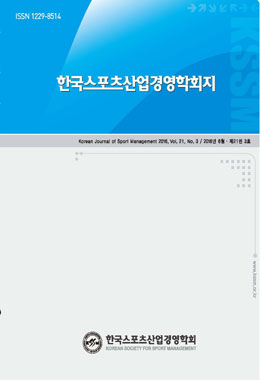정보통신기술의 발전과 스마트폰의 대중화로 인한 소비자들의 소비패턴 변화와 다양한 스포츠 컨텐츠에 대한 수요증가로 비교적 새로운 커머스인 스포츠 O2O서비스가 주목받고 있다. 이에 본 연구는 정보기술 수용과 이용행위의 이론적 유용성을 입증 받고 있는 기술 수용모델을 적용하여 스포츠 O2O서비스 잠재 고객의 이용의도와 관련 요인들 간의 영향관계를 구명하였다. 서울, 경기 지역 대학생 306명을 대상으로 설문조사를 실시하였으며 불성실한 설문을 제외한 총 301부가 최종 분석에 사용되었다. 자료처리를 위하여 PASW 18.0과 AMOS 18.0프로그램을 이용하였으며 빈도분석, 신뢰도분석, 확인적 요인분석, 그리고 구조방정식 모형 분석을 실시하여 다음과 같은 연구 결과를 도출하였다. 첫째, 건강 관심도는 지각된 유용성에 긍정적 영향을 미치는 것으로 나타났지만 지각된 용이성에는 유의미한 영향을 미치지 않는 것으로 나타났다. 둘째, 헬스리터러시는 지각된 용이성에 긍정적인 영향을 미치는 것으로 나타났지만 지각된 유용성에는 유의미한 영향을 미치지 않는 것으로 나타났다. 셋째, 지각된 용이성은 지각된 유용성에 긍정적인 영향을 미치는 것으로 나타났다. 넷째, 지각된 유용성은 이용의도에 긍정적인 영향을 미치는 반면 지각된 용이성은 유의미한 영향을 미치지 않는 것으로 나타났다. 이상의 연구 결과를 통하여 건강관심도와 지각된 유용성이 스포츠 O2O서비스 이용의도를 설명하는 중요한 변수로 나타났다.
The purpose of this study was to investigate the factors associated with customers` intention to use sport O2O service. In detail, this study used the theoretical framework of the Technology Acceptance Model(TAM) to assess the predictive roles of perceived ease of use, and perceived usefulness in using sport O2O service. As antecedent variables, health consciousness and health literacy were verified to have effects on this theoretical framework of Sport O2O service. This study used a questionnaire to collect data and a total of 301 data were collected for analysis. Respondents were the university students. The date was analyzed by PASW 18.0 and AMOS 18.0 by way of frequency analysis, reliability analysis, confirmatory factor analysis, and Structural Equation Modeling was performed to verify the relationship among factors. There are three major findings below. First of all, health consciousness did not have an impact on perceived ease of use although it was positively related to perceived usefulness. On the other hand, health literacy had opposite results from health consciousness. It was positively related to perceived ease of use although it did not have an impact on perceived usefulness. Secondly, perceived ease of use positively predicted perceived usefulness. Lastly, perceived ease of use did not have an effect on intentions to use Sport O2O services. However, perceived usefulness directly predicted the intentions to use Sport O2O services. This research has several implications. First, it will provide important academic foundations for O2O services in sports marketing. As research on sports-related O2O services is in an early stage, this study will drive further inquiry. Second, this study will contribute to the development of relatively new sports-related O2O services, which are likely to become a main source of revenue in the sporting industry in the future. Third, this study will provide practical information on the characteristics of potential customers and O2O businesses in the industry. The results of this study will provide meaningful information for both researchers and businesses that are searching for factors associated with sport O2O service usage intention.


